The Intel Core i3-7350K (60W) Review: Almost a Core i7-2600K
by Ian Cutress on February 3, 2017 8:00 AM ESTGrand Theft Auto V
The highly anticipated iteration of the Grand Theft Auto franchise finally hit the shelves on April 14th 2015, with both AMD and NVIDIA in tow to help optimize the title. GTA doesn’t provide graphical presets, but opens up the options to users and extends the boundaries by pushing even the hardest systems to the limit using Rockstar’s Advanced Game Engine. Whether the user is flying high in the mountains with long draw distances or dealing with assorted trash in the city, when cranked up to maximum it creates stunning visuals but hard work for both the CPU and the GPU.
For our test we have scripted a version of the in-game benchmark, relying only on the final part which combines a flight scene along with an in-city drive-by followed by a tanker explosion. For low end systems we test at 720p on the lowest settings, whereas mid and high end graphics play at 1080p with very high settings across the board. We record both the average frame rate and the percentage of frames under 60 FPS (16.6ms).
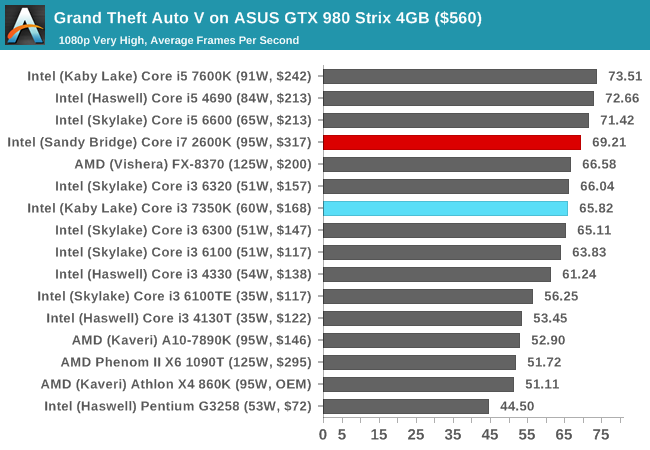
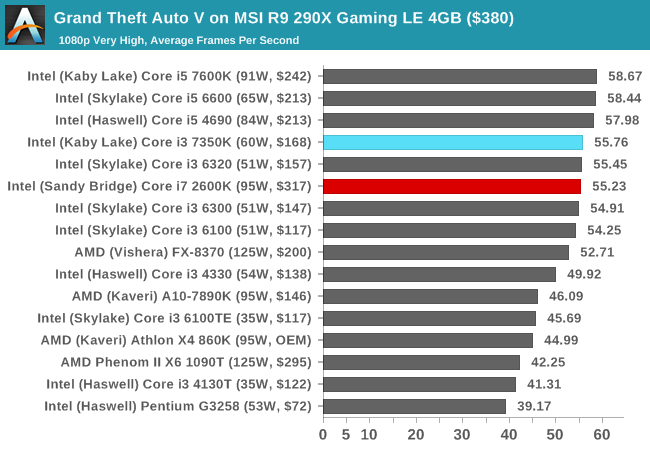
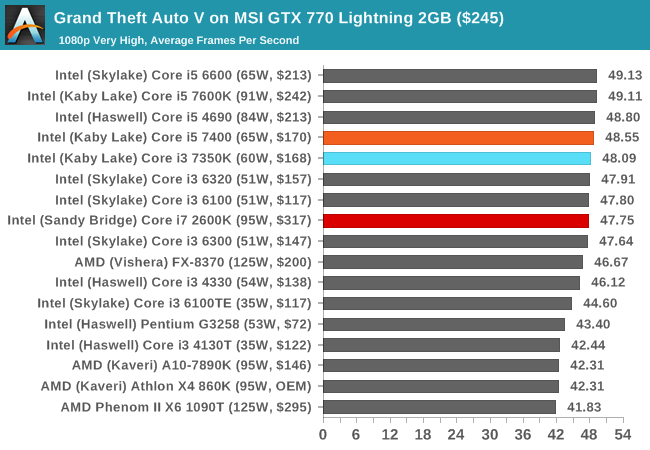

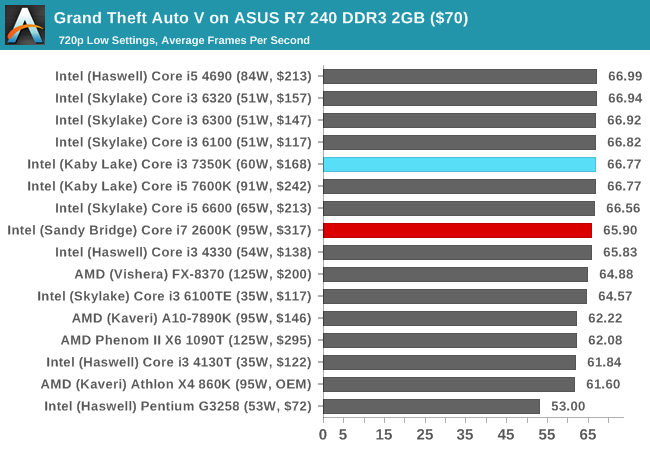
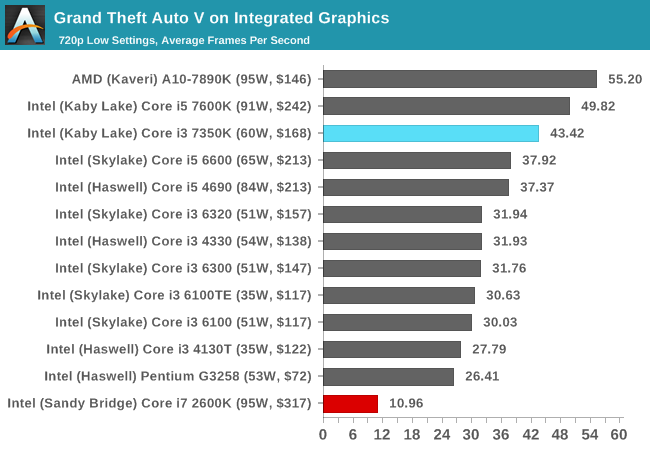
The older Core i7-2600K eeks out a small ~5 FPS advantage over the Core i3 when running a GTX 980 at 1080p maximum settings, but with all other GPUs the differences are minimal. With integrated graphics, the Core i3 shows it can pummel the older IGP into the ground.











186 Comments
View All Comments
BillBear - Friday, February 3, 2017 - link
For consumers who intend to purchase a discrete GPU card, it's interesting to see it confirmed that Intel could include four additional CPU cores in instead of the unnecessary (for you) integrated GPU within pretty much the exact same die size.It wouldn't cost them more to manufacture than an i7. They just want to be able to charge more money by forcing you into a different price range of product if you need many cores.
For instance: Intel’s new 10-core Core i7 Extreme Edition costs a whopping $1,723
http://www.geek.com/tech/intels-new-10-core-core-i...
fanofanand - Friday, February 3, 2017 - link
I'm not sure I agree with your assessment. Intel has a vested interest in pushing people like you into the HEDT platform which is far more profitable. If you have a powerful dGPU then you are not "mainstream" by Intel's thinking. Based on the number of computers that have no dGPU maybe they are right.BillBear - Friday, February 3, 2017 - link
You're just defending price gouging now.fanofanand - Sunday, February 5, 2017 - link
I am not defending anything, I am neither an Intel shareowner nor have they seen a penny of mine in a decade. I am saying that what they are doing makes business sense even if it doesn't suit you as well as you'd like.BillBear - Sunday, February 5, 2017 - link
For someone who frequently responds to other people's posts with silly BS like "This post brought to you by CompanyName" why are you suddenly defending price gouging on Intel's part?Price gouging makes business sense for any company. Tacking on an additional thousand dollars per part? Not really defensible.
block2 - Friday, February 3, 2017 - link
The CPU I want is one that costs me the least electricity for the 95% of the time when I'm on Facebook and surfing, yet supports Photoshop well. I bought a gold rated seasonic PSU a couple years ago and my overall power usage is very low (40w?). Really, a low end i3 ought to suffice for me. I'm still using a 2.8ghz AMD phenom II with the CPU throttling enabled (800mhz).Scipio Africanus - Friday, February 3, 2017 - link
Have you considered one of the Intel T suffix cores? They don't get a lot of coverage but give you the newest architecture with a very low TDP. The current Kaby Lake T cores are 35w TDP.The newest review i could find was for Haswell T cores:
http://www.anandtech.com/show/8774/intel-haswell-l...
Scipio Africanus - Friday, February 3, 2017 - link
It takes Intel 6 years to post 25% increase in single threaded performance? Yeesh. Competiton (read: Ryzen) can't come fast enough. My Sandy Bridge Dell Precision is staying put for a bit more.StrangerGuy - Friday, February 3, 2017 - link
And AMD did what exactly during the same 6 years? Sheesh.silverblue - Saturday, February 4, 2017 - link
Well, they've transformed a power-hungry server architecture into something that the majority of users could use in a mobile device without complaining about power or performance. I'm also pretty sure that if they had commissioned Zen even before Bulldozer's release, we still wouldn't have seen anything until recently. I'm not going to defend them for Bulldozer, but it was either trash it and work on a replacement with no money coming in or at least try to fix its problems with power, L1 and decoder, and redesign the FPU. A 25%+ IPC boost from Bulldozer to Excavator, despite the loss of L3, would have been much better received had Bulldozer been better to begin with. That's what AMD have been doing.